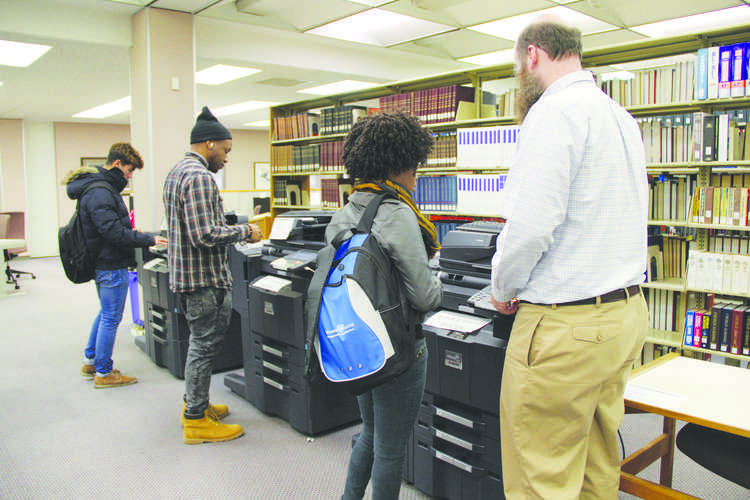FMU printing policy reduces paper waste
Photo by: Christina Xan
The printing policy introduced last semester has saved enough paper to equal at least 100 trees, Joyce Durant, dean of James A. Rogers Library, said. According to Durant, in just one semester, printing has reduced by 72 percent, helping decrease spending and FMU’s environmental footprint.
FMU officials recently addressed students’ concerns about the printing policy that was enacted in fall 2015.
The new policy was designed to fix environmental and financial issues that were caused by excessive printing in the James A. Rogers Library, the Stanton Academic Computer Center, the Cauthen Educational Media Center computer lab and several department computer labs.
FMU has been looking at other universities’ printing policies to brainstorm ways to solve the problem since 2004, according to the dean of the library Joyce Durant. The university tracked the paper waste over the past decade, and there has been a decrease in waste since the policy took place.
“The results of the program have greatly exceeded expectations,” Durant said. “Through this program, the total savings of paper and printing costs for the university exceeded $20,000 for the fall semester. This reduction yielded an immediate positive environmental impact, saving approximately 894,543 sheets of paper and dramatically reduced the number of waste toner cartridges.”
There was a 72 percent reduction in the number of prints from spring 2015 to fall 2015, and the pages saved from printing could be compared to saving 100 trees, Durant said. Since the policy began, the library has placed three large recycling bins in the lobby to visually show students how much paper was being wasted.
Financially, the excessive printing was causing a burden on FMU because of rising paper costs. Durant said the prices for printing have raised annually from approximately $18,000 to $20-25,000.
One factor that contributed to the massive waste, Durant said, was that the community was allowed to print for free, just like students were. By requiring a student ID on both the computer and the printer, the community is not able to print, saving FMU money and paper.
Part of deciding what to charge students for printing involved researching printing prices at other universities in South Carolina. Some of the universities that FMU looked at, such as the University of South Carolina and Winthrop University, charged anywhere from four cents to 10 cents per page.
FMU decided to give students $12.50 on their accounts for yearly use. According to Mark Lancaster, a network operation specialist at FMU’s campus technology, the $12.50 will be reset on students’ accounts in fall 2016. Students who begin school at FMU during spring 2017 will be given $6.25 on their accounts. Unused credit will not roll over to the next semester.
Student Government Association (SGA) has been discussing ways to address students’ concerns with the new policy. Sam Smoot, president of SGA, said that as people have become more accustomed to the policy, fewer students have complained.
One of the problems that SGA is still addressing, though, is campus organizations paying to print their handouts.
“The procedure we have now is not going to go away,” Smoot said. “For organizations who do have to print out flyers, we are in Student Affairs to see if we can accompany all the needs of printing.” Students have had different reactions to the printing policy at FMU.
“I think that the new policy is an improvement because many students take advantage of free printing,” Carl Bing, a sophomore political science major, said. “I believe it is also beneficial using our IDs now because that saves from having to find our individual work in a cluster of other students’ work. That prevents things from getting accidentally taken or taken away.”
Bing did, however, that he does not think $12.50 is enough for each year.
“ I believe that students should invest in getting their own printers,” Bing said. “I go to the library less often this semester since I decided to buy one.”
Gregory Pilot, sophomore industrial engineering major, said that he doesn’t go print at the library as often either.
“This semester I have gotten my own printer and feel that this may be a better option when you are required to print a lot of material but don’t have the money to constantly pay for printing even though it’s cheap.”
Durant has confirmed that the policy is here to stay because it has been successful in reducing environmental and financial costs.
